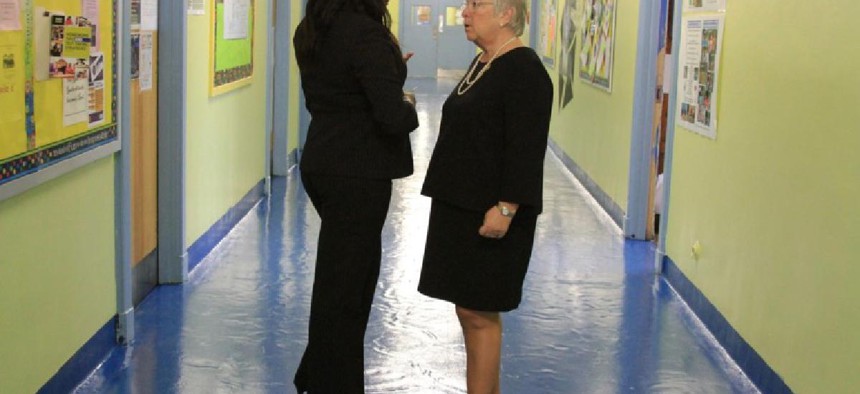But for some city principals, the boycott poses a set of less ideological questions: Could it affect their ability to get a full view of students’ abilities? Could they be sanctioned if they are suspected of pressing their thumb to the scale in conversations with parents? Could students without test scores struggle to get into competitive high schools?
In interviews with a handful of school leaders, principals offered a range of answers. Principals at schools with high opt-out rates seem largely unconcerned about the consequences, with a couple of notable exceptions. And for many others, the debate is simply a non-issue in their school community.
Mark Federman, echoing several other principals, says he wasn’t worried about high opt-out rates resulting in the loss of valuable data on students’ math and reading skills over time.
“We just view [the state tests] as a small bit of information,” said Federman, principal at Manhattan’s East Side Community School, where roughly 20 percent of students opted out last year. “If you go to the doctor and say, ‘I’m having headaches,’ they’re going to take my blood pressure, they might give me an MRI. Every little bit of information you can get about a kid helps.”
The tests “work really well for people outside of schools,” he said, referring to politicians and policymakers who often think the tests give them useful information. “But for educators, they don’t really give us what we need.”
Arguments that there could be severe consequences for schools that look the other way, or actually encourage the boycotts, also seem thin to principals at schools with high opt-out rates last year. A few of those principals said they didn’t get pushback from the education department.
Part of the reason is likely that the policy winds are shifting: The state math and reading assessments have been detached from teacher evaluations, and despite threats from the federal government to withhold funding from districts with high opt-out rates, many educators see those as empty. The state’s top education official has even signaled hersupport for the boycotts.
Still, some educators worry that even if there are no external consequences, opting out could hurt students in the high school admissions process.
Stacy Goldstein, who runs the School of the Future in Manhattan, says she is sympathetic to parents who want to opt out, but has encouraged some parents to reconsider, as it can be difficult to understand exactly how selective schools weigh test scores in the admissions process.
“I tell them to feel it out [and] do their due diligence,” she said. “I tell them to be kind of cynical about it.”
“If you’re the parent of a seventh grader and you’re worried about what high school you’re going to, that’s a legitimate issue,” echoed Brooklyn New School’s Anna Allanbrook, a vocal test critic who said the drawbacks of opting out are outweighed by the benefits. Her school had a 95 percent opt-out rate last year.
Goldstein isn’t predicting anything that high at her school. Even though virtually no students opted out at her school last year, she anticipates a jump to a roughly 10 percent opt-out rate.
For principals like Goldstein, the prospect of a big jump in opt-outs also creates new logistical hurdles. How should teachers handle time allocated for test prep so that students who boycott the tests don’t simply check out without consequence?
“I get worried that it splits the class,” Goldstein said, “and then the teacher has to negotiate the kids who are and kids who aren’t [opting out].” She plans to assign reading about the testing debate for the students who opt out and require they write an essay during the exam time.
But others aren’t addressing the issue at all, either to avoid wading into potential controversy or because their families simply aren’t talking about it. Even though a record-breaking 20 percent of students statewide boycotted the exams last year, fewer than 2 percent of students citywide sat out.
“It’s not something we are actually talking about,” said Jazmin Rivera Polanco, principal of Entrada Academy, a Bronx school that is part of Mayor Bill de Blasio’s “Renewal” program. Last year, her school reported virtually no opt-outs.
Polanco said she doesn’t believe that many of her students, a third of whom are English language learners, should have to take the tests at all because of their limited exposure to the language. Polanco is reluctant to discuss that with parents, even though many of them incorrectly believe their children could be held back if they refuse the tests.
“We don’t want to say something that would be seen as jumping the gun, or saying information that those in the DOE might not find that it’s our place to [say],” Polanco added.
Multiple principals interviewed for this story expressed uneasiness talking about how their schools were handling students who boycott. And the education department has cautioned teachers against expressing their opinions about the tests.
“Schools have spent so many years answering to those test scores,” said Julia Zuckerman, principal of the Castle Bridge School, where not a single student sat for the state tests last year. “To think that there’s another way of doing it is a tricky position to take.”
Goldstein at School of the Future put it much more bluntly.
Since she became a principal, “I feel much more strongly that these tests are problematic,” she said. “But I want to make sure that [the opt-out movement] is not feeding into a sense of entitlement or laziness.”
“I still want rigor,” she said. “I still want assessment.”
This article was first published on Chalkbeat New York on April 5.


